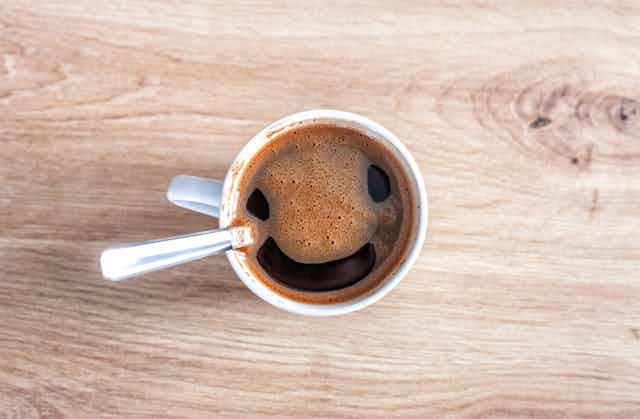Sometimes we see faces that aren’t really there. You may be looking at the front of a car or a burnt piece of toast when you notice a face-like pattern. This is called face pareidolia and is a mistake made by the brain’s face detection system.
But it’s an error that can help us understand the workings of the human mind. A recent study has argued that having a baby may affect this aspect of our brains, suggesting it may vary across our lifetimes.
Many scientific studies exclude pregnant women out of concern that the dramatic changes to their hormone levels may affect results. But researchers from the University of Queensland in Australia realised these hormonal changes can give us interesting insights.
They found women who had had recently given birth were more likely to see face-like patterns than those who were pregnant. The researchers have suggested this might be because of changing levels of the hormone oxytocin. However, the full picture may be more complicated.
People have evolved to be sensitive to faces and face-like patterns from birth, probably because attention to faces underlies our social interactions and may also help us stay safe (it’s how we tell friends and family from strangers). Monkeys also show face pareidolia, suggesting that we share features of our face-detection system, including the mistakes that it makes, with other species.
It’s well established that chemical messengers in the brain play a role in our social interactions. For instance, oxytocin is often called the “love hormone” due to its links with social bonding and reproduction. Studies have shown that artificially increasing levels of oxytocin, using a nasal spray, causes people to spend longer looking at the eye regions of faces and enhances recognition of positive facial expressions.
Oxytocin levels change naturally within women who are pregnant and after they have given birth. Previous research that compared women at different stages in their pregnancy and postpartum has found that levels of oxytocin and other hormones vary dramatically.
The Australian researchers decided to test whether levels of oxytocin (given its role in face perception) and the likelihood of seeing face-like patterns are related to each other. They predicted that postpartum women would have higher levels of oxytocin than pregnant women, therefore making it easier for them to see faces in face-like patterns.
Seeing faces in objects
The researchers compared two groups of women on a test of face pareidolia. One group were pregnant while the other group had given birth in the last 12 months. During the test, all of the women were shown three types of images: human faces, ordinary objects and illusory faces (objects with face-like patterns in them). The women were asked to respond to the images using an 11-point scale from zero (no, I don’t see a face) to ten (yes, I definitely see a face).
The results showed that the postpartum women did indeed report seeing more faces for the illusory face images (median response was 7.08) in comparison with the pregnant women (median response of 5.30). As expected, these groups didn’t differ much in their responses to the images of human faces and ordinary objects.
The authors concluded that women’s sensitivity to levels of face pareidolia may be heightened during early parenthood, and might encourage social bonding, which is obviously important for mothers and their infants. This increase in sensitivity, according to the researchers, is caused by heightened levels of oxytocin in the months after giving birth.

The authors of the study noted that they didn’t actually measure their participants’ oxytocin levels. Instead, they assumed oxytocin differences caused the differences in face pareidolia.
However, this means other differences between the two groups may have led to their result. Perhaps pregnant and postpartum women differ in their levels of anxiety, stress, or fatigue, all of which could affect their performance on the task.
It may also be that pregnant and postpartum women who choose to complete online psychology experiments differ in some way that we’re not aware of. Carrying out a follow-up study which compares the same women during pregnancy and after they’ve given birth could rule out some of these alternatives.
There is also another problem with assuming that oxytocin differences underlie the face pareidolia result. While the study’s authors reason that oxytocin levels will be higher postpartum than during pregnancy, this idea isn’t clearly supported by previous research.
In fact, some studies seem to show that oxytocin levels don’t differ from pregnancy to postpartum, are lower postpartum, or that they rise during pregnancy but then fall during the postpartum period. At the very least, these studies seem to agree that women vary greatly in the patterns they show.
Some more than others
While the Australian study focused on pregnant and postpartum women, we know that most people experience seeing face-like patterns. However, there are large differences in how susceptible you might be.
For instance, studies have shown that women report seeing these illusory faces more often than men do, while strong believers in paranormal phenomena and religions show more frequent experiences than sceptics and non-believers. Researchers have even found that loneliness may cause people to see these face-like patterns more often.
Face pareidolia is also less commonly experienced by some groups like those with autism spectrum disorder, as well as genetic disorders like Williams syndrome and Down syndrome.
And we know that some people are “face blind” (prosopagnosic) and can struggle to recognise even their family and close friends. These people also show less sensitivity to face-like patterns.
As a preliminary study, this team’s new finding that postpartum women show increased face pareidolia is certainly an interesting one. If sensitivity to face-like patterns changes across our lifetimes, and is also determined by underlying hormone levels, then measuring face pareidolia could represent a useful tool for monitoring more complex internal changes that might underlie mental health issues.

